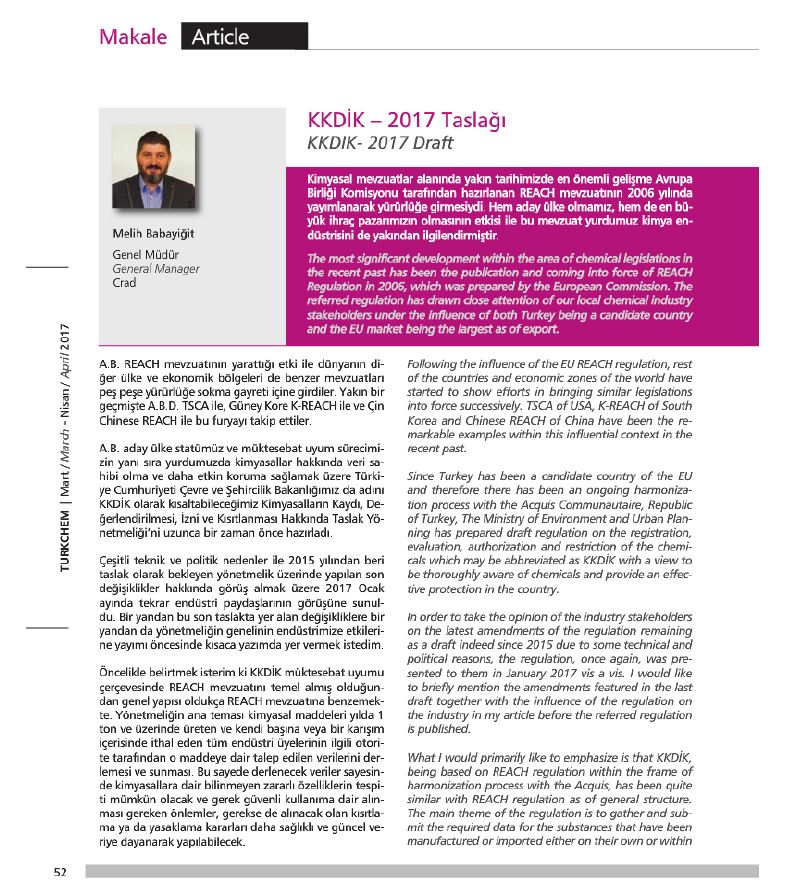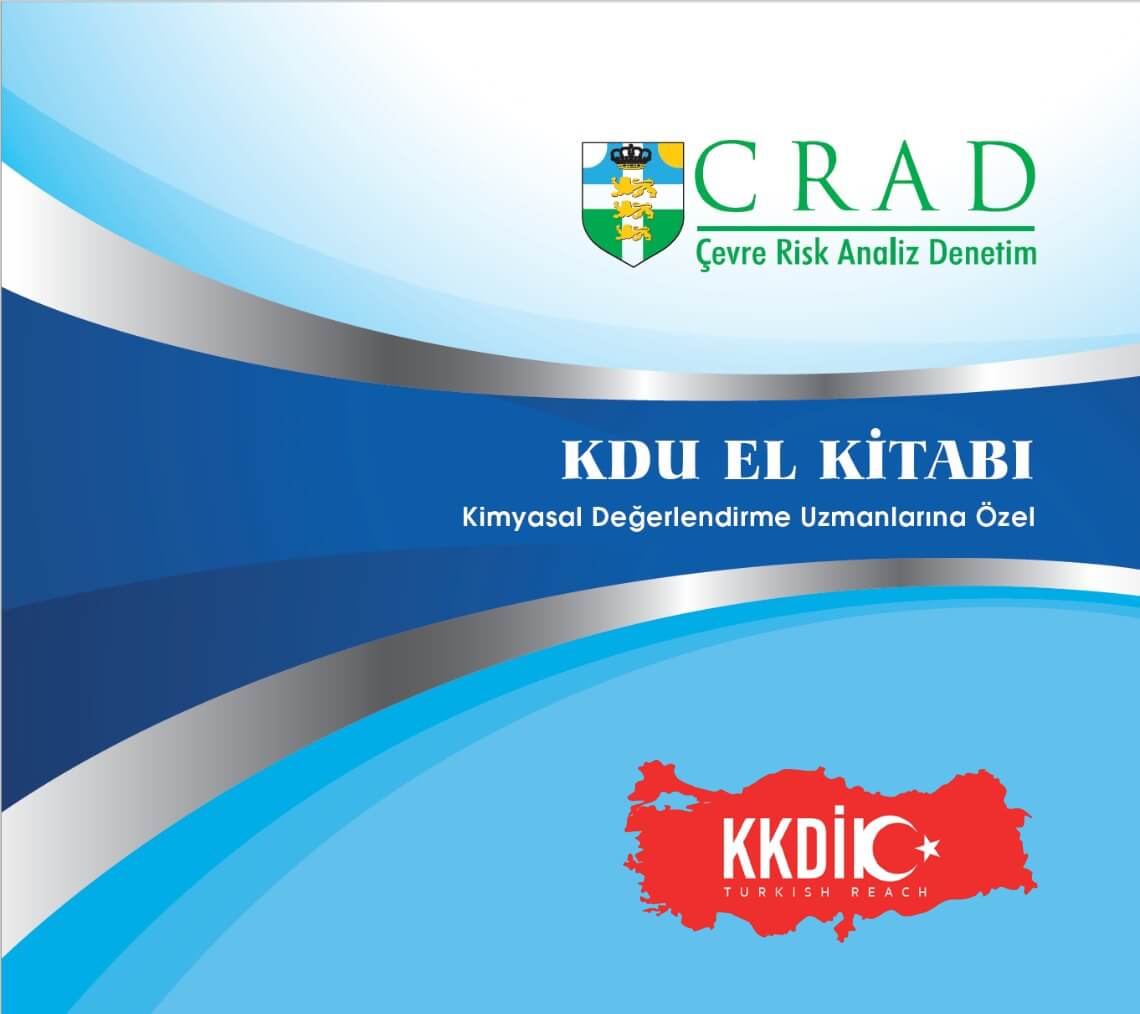KKDİK – 2017 DRAFT

The most significant development within the area of chemical legislations in the recent past has been the publication and coming into force of REACH Regulation in 2006, which was prepared by the European Commission. The referred regulation has drawn close attention of our local chemical industry stakeholders under the influence of both Turkey being a candidate country and the EU market being the largest as of export.
Following the influence of the EU REACH regulation, rest of the countries and economic zones of the world have started to show efforts in bringing similar legislations into force successively. TSCA of USA, K-REACH of South Korea and Chinese REACH of China have been the remarkable examples within this influential context in the recent past.
Since Turkey has been a candidate country of the EU and therefore there has been an ongoing harmonization process with the Acquis Communautaire, Republic of Turkey, The Ministry of Environment and Urban Planning has prepared draft regulation on the registration, evaluation, authorization and restriction of the chemicals which may be abbreviated as KKDİK with a view to be thoroughly aware of chemicals and provide an effective protection in the country.
In order to take the opinion of the industry stakeholders on the latest amendments of the regulation remaining as a draft indeed since 2015 due to some technical and political reasons, the regulation, once again, was presented to them in January 2017 vis a vis. I would like to briefly mention the amendments featured in the last draft together with the influence of the regulation on the industry in my article before the referred regulation is published.
What I would primarily like to emphasize is that KKDİK, being based on REACH regulation within the frame of harmonization process with the Acquis, has been quite similar with REACH regulation as of general structure. The main theme of the regulation is to gather and submit the required data for the substances that have been manufactured or imported either on their own or within a mixture over 1 metric tonne per annum by manufacturers or importers. By means of data gathered in this respect, identification of the unknown harmful effects of the chemicals will be possible and therefore, both measures for safe use and the decisions to be taken for restrictions and prohibitions will be able to be rendered on the basis of a more sound and up to date information.
According to the latest draft published, only one article of the regulation has been the point at issue to come into force after being published in the Official Journal. And that article is the one that repeals the CICR regulation (Chemical Inventory and Control Regulation No 27092) All other articles will be in force starting from the sixth month from the date of publication and the enforcement of provisions on restrictions and registrations applies in a period that ends with 2025.
In general, it is expected that the regulation will be published with in 2017. Otherwise the first draft which was texted in 2014 and had been amended several times and released for consultation, will again have to be amended prior to publication due to the domino effect of the implementation and enforcement dates. Also more delay on its publication may cause to face the risk of disregard and reluctance to the KKDIK which is widely called as Turkish REACH, despite the interest of the global chemical industry which indeed deserves.
When we review the critical dates based on the latest draft;
• Pre-registrations for any substance manufactured or imported 1 mta or above have to be submitted starting from the sixth month of publication till 31.12.2019
Registrations for the pre-registered substances have to be submitted between the dates 1.1.2020 and 31.12.2022.
After 31.12.2022 substance manufactured or imported above 1 mta can only be placed on the market after registration.
The SDS have to comply with KKDIK after 31.12.2022. Till that date the SDS can comply with KKDIK or the existing SDS regulation.
Restrictions (annex XVII) will apply per the details given in the regulation respectively varying from 6 months after the publication, 31/12/2018, 31/12/2019, 31/12/2021.
One of the critical amendments that are implemented to the latest draft KKDIK is the annulment of the below article which may potentially prevent the new entrepreneurs who initiate a business after the pre registration deadline but before the registration deadline.
Former Draft of KKDIK / Temporary Article 2:
Companies that did not submitted a pre-registration before 31.12.2018, can not place the substances on the market before registration, starting from that date.
As understood from this article which was annulled; a new entrepreneur who missed the pre-registration period would not be able to place their products on the market before registration. With this annulment it gives an opportunity for the new entrepreneurs who initiate a business after the end of the pre-registration period.
Other than these details for sure the critical point of KKDIK which is the main theme of it is; how the data that is required by the KKDIK Registration dossiers and be the basis of the Chemical Safety Assessments, will be provided. In this mean as we all already know that all these data had already been gathered by SIEF’s under the scope of REACH and had been made available to ECHA, it would neither be feasible nor create a value by means of human resources and time. In brief It is meaningless to discover the America again! For that reason, the general expectation is the data that is already gathered by the SIEF’s under the scope of REACH is to be used for KKDIK registration purposes by the existing owners of Letters of Access with an extra premium paid on the top of the LoA fees. Same may apply for the local registrants to pay the extra LoA fee and be able to use the same data under a joint registration. For sure we should as well consider the requirement that the robust study reports and the Chemical Safety Assessment Reports should be translated into Turkish by a certified chemical safety assessor.
When we handle the issue from the importers perspective; for sure instead of each importer of a substance submitting a registration, a registration that is submitted by the OR that is appointed by a global manufacturer covering all importers of the substance with in Turkey would be much more economic and practical. Also it needs to be considered that the importers which varies in size, especially the ones who are SME’s would hardly find fiscal and human resources for compliance.
Remembering that our exporters who are exporting their products to the EU had to comply with REACH regulation in order to be able to export their products, the Global Chemical industry who wishes to export their products to Turkey should as well had to consider to comply with the KKDIK and meet their expectations and demands on this context. For sure I wish to express that we have to be aware of the options we have and be demanding with in this context.
















